
* The helicopter was not the first successful rotorcraft, that honor going to the "autogyro", invented by Juan de la Cierva of Spain in the 1920s. Although there was considerable enthusiasm over the concept in the 1930s, the development of helicopters during World War II suspended work on "gyroplanes", as autogyros are sometimes called, for serious aviation roles, -- though they have thrived in the hobbyist market, and some companies believe that the concept has unused potential. This document gives a history and description of the autogyro / gyroplane. A list of illustration credits is included at the end.
* Experiments with piloted rotary-wing machines went back to before the First World War, when the Frenchmen Paul Cornu and Louis Breguet, the Ukrainian Igor Sikorsky, and others built helicopters that at best could hop up off the ground, but were not capable of sustained controlled flight.
The first person to build a practical rotorcraft was Juan de la Cierva, who was born in Murcia, Spain, in 1895. He acquired an engineering degree and became a pioneer of Spanish aviation, working on various aircraft projects before and into the First World War. In 1919, he was considering the crash of a bomber that had stalled, when he came up with the idea of a stall-proof airplane. All he had to do was mount a free-spinning rotor above the airplane, partly or completely replacing the normal fixed wings. In forward flight, the aircraft's engine and propeller would force a draft through the rotor, generating lift -- incidentally resulting in a short take-off -- and if the engine failed, the spinning rotor would "autorotate", spinning as the machine fell to result in a soft landing. He patented the concept, calling the machine an "autogiro". Having staked that name, everybody else had to call them "autogyros", which for the sake of simplicity is the usage here.
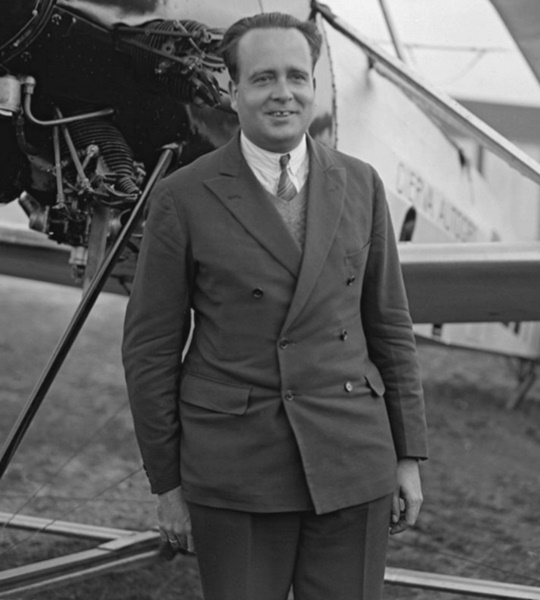
Beginning in 1920, Cierva built a series of autogyro demonstrators, beginning with the "C.1", which didn't work. The following "C.2" and "C.3" didn't work either -- but his fourth try was the charm, with the "C.4" credited as performing the first recorded successful flight of a rotary-winged machine on 17 January 1923, with Gomez Spencer at the controls. The C.4 was modified from a wartime French Hanriot fighter and still had wings for flight control.
One of the problems that Cierva had encountered with his early machines was "asymmetry of lift". If a rotary-wing machine is moving forward, the rotor blade that's spinning forward generates more lift than the rotor blade that's spinning backward. The result is that the machine tended to tip over. Cierva's solution was to hinge the rotor blades to the hub, allowing them a degree of travel up-and-down and back-and-forth. Although such a simple scheme sounds like it could have been a disaster, in fact the movement of the blades compensated very well, rising as they moved forward and falling as they moved back. A rotor blade tilting up tended to lose lift, balancing the autogyro. He stumbled onto the idea by accident while tinkering with a rubber-band-powered model, and then fitted the hinged rotor scheme to the C.4.
There were other difficulties to work out, in particular the problem that the fixed wings of the C.4 couldn't control the flight of the aircraft at low speeds, and Cierva hadn't figured out how to obtain flight control with the rotor system yet. He continued his research with the "C.5" of 1923, and then the "C.6 / C.6A / C.6B" of 1924, which was based an Avro 504K fighter. The C.6A was the first of the series to chance a cross-country flight, on 12 December 1924.
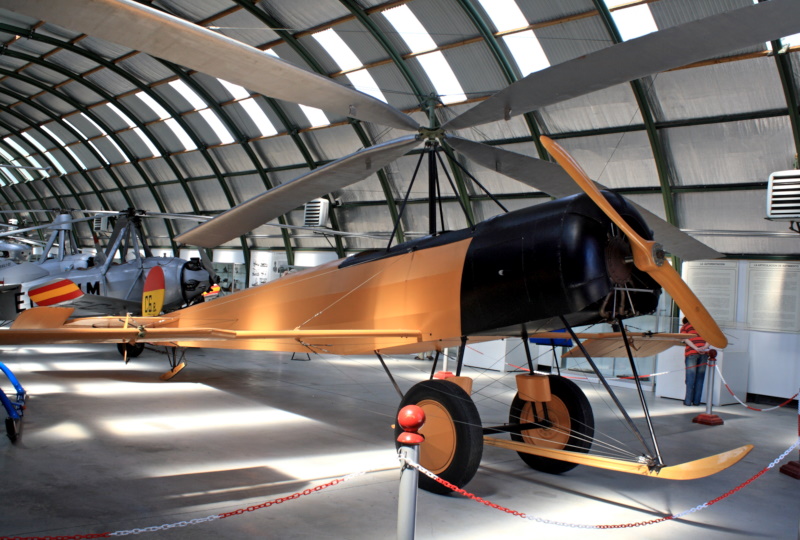
In the fall of 1925, Cierva demonstrated the C.6A to the British military, with the British Air Ministry interested enough to order several autogyros for evaluation. They were to be built by Avro; Cierva, backed by a group of British industrialists, decided to set up his own firm, "Cierva Autogyro LTD", in the UK to focus British interest. Along with the construction of two "C.7" autogyros by Jorge Loring in Spain, Avro built a litter of "C.8" series machines with variations in configuration for evaluation. A few were also sold on the export market.
* At this point, the story becomes more complicated as Cierva obtained licensees in a number of countries. Avro stayed with the concept, working on:
A total of almost a hundred C.19, C.30, and C.40 machines was built by Avro, with some operated by the British Royal Air Force under the designations of "Rota Mark I", "Rota Mark IA", and "Rota Mark II" respectively. Some were also sold to the civil or export markets.
In the meantime, Cierva was working with various other licensees, one of the most prominent being Harold Pitcairn of Pennsylvania. Pitcairn was an aviation enthusiast from the early days and had taken an interest in Cierva's autogyros, ordering a C.8 and flying it in 1928. It was the first operational rotary-wing aircraft to fly in the United States. Pitcairn's firm, the "Pitcairn-Cierva Autogyro (PCA) Company", gave him a platform to allow him to help refine the design, and soon he was flying a series of developmental aircraft -- beginning with the "PCA-1", followed by the "PCA-1A" and "PCA-1B". It was his fourth machine, the "PCA-2", that really captured public attention, through a series of demonstration flights over US cities beginning in late 1931 and continuing into 1932.
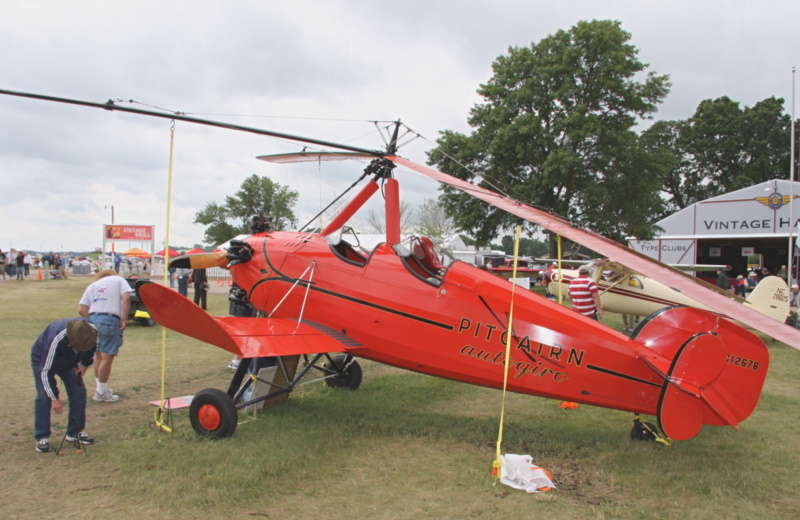
The Kellett company of the USA also got into the autogyro business, building a series of "KD-1" machines along the lines of the Cierva C.30, one of which achieved notoriety for being used on an experimental mail run in Washington DC in 1939. A Kellett autogyro was taken on an Antarctic expedition by US Navy Admiral Richard Byrd in 1933, being lost in a crash in 1934.
The US Army was interested in autogyros and evaluated a number of Kellett machines from 1935 under the general designation of "YG-1", with the US Army Air Forces (USAAF) following up this effort during 1942 by obtaining a handful of "XO-60 / YO-60" autogyros for the battlefield observation role. The USAAF never put autogyros into combat, however, and though Kellett did modify some of their machines to more powerful "XR-2 / XR-3" prototypes, the company decided to get out of the business.

A number of companies all over the world also built Cierva autogyros:
* In maturity, the autogyro was a perfectly practical flying machine. Cierva had figured out how to control flight without use of fixed wings, using two innovations:
Pitcairn added a useful innovation of his own, the "pre-rotor", which coupled the engine to the rotor while on the ground, allowing the machine to spin up the rotor before trying to take off, reducing take-off run -- or even, if the rotor were spun up enough, achieve a vertical "jump take-off". Cierva had already considered the idea, but was using a rope pull starter to get the rotor spinning.
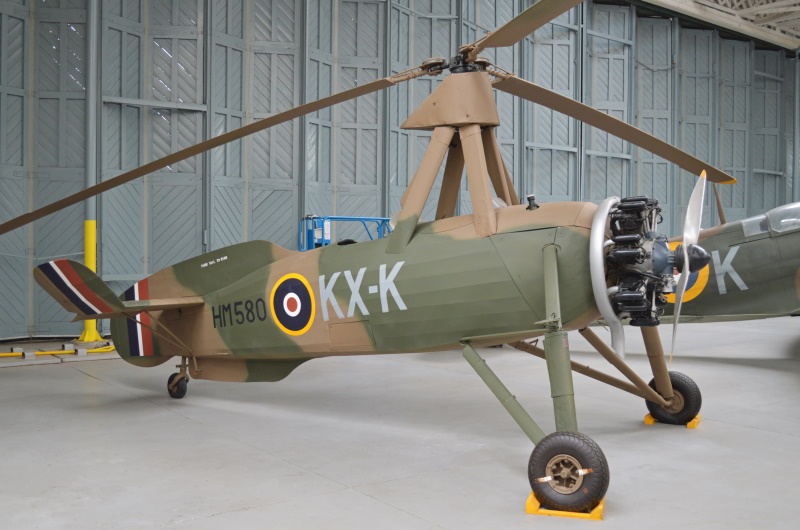
The two-seat Cierva C.30 / Avro Rota Mark IA makes a good benchmark for the Cierva machines, the C.19 and C.40 being of roughly similar configuration aside from the seating arrangements. It had no wings; a "tadpole"-like tailfin that wrapped around the tail, with a tailplane tipped with auxiliary tailfins; a three-bladed rotor; and tandem open cockpits. It was powered by an Armstrong-Siddeley Civet 1 air-cooled radial engine providing 104 kW (140 HP).
___________________________________________________________________
CIERVA C.30 / AVRO ROTA MARK IA:
___________________________________________________________________
rotor diameter:
11.28 meters (37 feet)
fuselage length:
6.02 meters (19 feet 9 inches)
height:
3.38 meters (11 feet 1 inch)
empty weight:
555 kilograms (1,220 pounds)
max loaded weight:
815 kilograms (1,800 pounds)
maximum speed:
175 KPH (110 MPH / 95 KT)
ceiling:
2,440 meters (8,000 feet)
range:
460 kilometers (285 MI / 250 NMI)
___________________________________________________________________
* Although Cierva developed the autogyro into a safe and effective machine, even as the technology appeared to be ready for widespread use, events were conspiring to shoot it down. The first was the death of Cierva at age 41 in the crash of a Dutch Douglas DC-2 airliner in England on 9 December 1936. The second was the flight of the first unarguably workable helicopter, the German Focke-Achgelis Fa 61, in 1938, making the autogyro seem like a half-measure and focusing work on true helicopters. The third was the outbreak of World War II in the next year, 1939, with industrial development focusing on weapons needed in the conflict.
Autogyros saw very limited use during the war. Avro Rotas were used by the RAF for radar calibration duties, with an autogyro stationed near a radar station to provide a flying "target" for radar observation. The Japanese pressed their Kayaba machines into service late in the war as antisubmarine warfare platforms, carrying two depth-charges each, making them likely the only autogyros to ever carry a combat load. Some Soviet TsAGI autogyros were used in the observation role during the war with the Germans.
However, by the end of the conflict, helicopter development was going full steam, and Cierva's autogyro had become a curiosity at best. The Cierva company survived his death, under the direction of Dr. J.A.J. Bennett, but focused on development of helicopters. It would develop one of the first British-designed helicopters, which would become the "Sanders-Roe Skeeter" after the Cierva firm was absorbed by the Sanders-Roe company. Still, Cierva had designed the world's first practical rotorcraft, and had solved a number of problems needed for helicopter development. He would not be forgotten, and work would continue, if at a modest level, on his autogyros.
BACK_TO_TOP* There was some development of Cierva's ideas during the war, the most prominent being the German Focke-Achgelis "Fa 330 Bachstelze (Wagtail)". It was what as known as a "rotor kite" or "gyrokite" or "gyroglider", which had to be towed into the air since it lacked an engine. It looked a little like an ultralight helicopter, with a metal-tube frame, a standard aircraft tail assembly, and the pilot sitting exposed on a frame seat under a rotor. It had a three-bladed rotor with a diameter of 8.5 meters / 28 feet (7.3 meters / 24 feet in early production), and a total weight of about 72 kilograms (160 pounds).

The Fa 330 was intended to be towed by a submarine to spot targets. A few hundred were built, but it appears they were not put to much use, since German U-boat captains were reluctant to do anything that kept them from diving in a hurry to escape Allied destroyers and sub-hunter aircraft. The Fa 330 was mostly a curiosity in hindsight.
The British developed a gyrokite along much the same lines, developed by an Austrian named Raoul Hafner and called the "Rotachute". It was intended to drop paratroops or agents, but it never went into production. The British then even experimented with a light ground vehicle fitted with a rotor for airdropping, but nothing came of the "Rotabuggy" either. However, the Fa-330 and the Rotachute would contribute to keeping the autogyro alive over the longer term.

* Igor Bensen had been born in Russia in 1917, with his family fleeing the Russian Civil War a few years later. He went to the University of Louvain in Belgium to work towards an engineering degree, obtaining a scholarship for further studies at Stevens Institute in the United States in 1937. He graduated in 1940 and was hired by the General Electric company, which at the time was interested in helicopters and put him to work on the technology.
In 1943, Bensen got the opportunity to fly a Kellett XR-3, becoming a skilled autogyro pilot. When he found out that the US Army Air Forces had obtained some Fa-330 rotor kites and a Hafner Rotachute, he was intrigued enough to lobby the military for use of the Rotachute -- which he flew himself, though the military had specified that it not be flown. Bensen's investigation led to development of his first gyrokite, the Bensen "B-1". It was of mixed wood-metal construction; it abandoned the three-blade flapping rotor system of the Rotachute in favor of a "teetering rotor", a two-blade assembly fixed across its length that tilted to one side or another on the rotor hub to deal with asymmetric lift. The B-1 crashed, leading to the all-metal "B-2", which was the basis for a "GE Gyro-Glider" that never reached the market.
In 1951, Bensen joined Kaman Aircraft Company to work on helicopters, but after two years, he dropped out to form the "Bensen Aircraft Corporation" in Raleigh, North Carolina, borrowing money from his brother to set up shop. In 1953 he introduced his "B-5" gyro-glider. It could be bought complete, or as the "B-6" in kit form, or just as plans. It led in turn by the summer of 1955 to the "B-7" gyro-glider, followed before the end of the year with the "B-7M" -- "M" for "motorized" of course -- powered by a 31 kW (42 HP) Nelson two-stroke piston engine driving a pusher prop.
Bensen had suffered a forced but safe landing in the B-7M and so did some minor redesign, resulting in the definitive "B-8" gyro-glider and "B-8M" autogyro -- or "gyrocopter" as he trademarked it, that term becoming the property of Bensen. It was in production by 1957, being sold complete, in kit form, or as plans. It would prove a popular ultralight aircraft. In 1962, Bensen helped found the Popular Rotorcraft Association (PRA) to help promote use of ultralight rotorcraft.
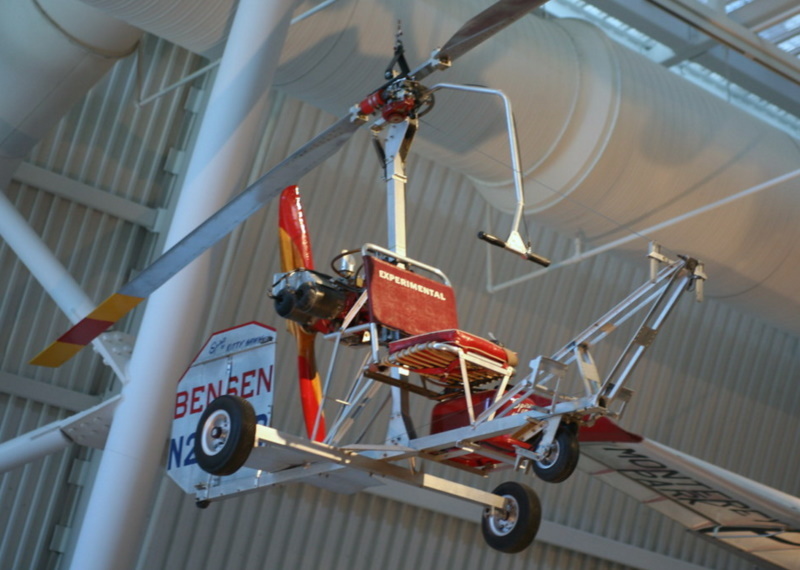
The B-8M was built of aluminum tubing, with a two-blade teetering rotor and an overhead cyclic control stick; the rotor had fixed pitch, which would be common in machines of its class. The B-8M was powered by a 54 kW (72 HP) McCulloch two-stroke piston engine and could take off in about 15 meters (50 feet), and land almost vertically through autorotation. The B-8M could taxi fairly well and could be in principle driven on city streets with the rotor tied fore and aft -- though despite the existence of publicity shots showing this being done, it seems likely local police tended to have an opinion on whether it was a good idea or not.
___________________________________________________________________
BENSEN B-8M GYROCOPTER:
___________________________________________________________________
rotor diameter:
6.10 meters (50 feet)
fuselage length:
3.45 meters (11 feet 4 inches)
height:
1.9 meters (6 feet 3 inches)
empty weight:
112 kilograms (250 pounds)
max loaded weight:
225 kilograms (500 pounds)
maximum speed:
135 KPH (85 MPH / 75 KT)
ceiling:
5,000 meters (16,500 feet)
range:
160 kilometers (100 MI / 85 NMI)
endurance:
90 minutes
___________________________________________________________________
A pontoon-equipped variant, the "B-8MW", was also available. A "B-8V", powered by a Volkswagen flat-four air-cooled engine, was offered as well, presumably to appeal to kitbuilders who had their hands on a VW engine. A B-8M and a B-8 were acquired by the US Air Force in 1968 under the designation of "X-25A" and "X-25B" respectively to investigate, ironically, the old Rotachute concept of a controlled parachute, or what the service called the "Discretionary Descent Vehicle (DDV)".
Igor Bensen was quite the tinkerer and obtaining a full and accurate list of every flying machine he ever built would be difficult, but a short list of some of the highlights is interesting enough:
* The Bensen Aircraft Corporation finally closed its doors in 1986 after over 30 years of existence, Bensen dying in 2000. The reasons for the company's closure are unclear. There were those who claim the teeter-bar rotor configuration is dangerously unstable; advocates reply that the handling of an autogyro isn't troublesome, it's just different. It doesn't fly like a fixed-wing airplane, and it doesn't really fly like a helicopter either, with airflow going up through the rotor instead of being driven down. One peculiarity is that abrupt changes in pitch can "unload" the rotor, with the machine then dropping, resulting in oscillations or even a deadly somersault -- if the pilot fights it, instead of allowing the machine to smoothly recover. Stall recovery, in effect, is automatic.
The accident rate of the Bensen gyrocopter doesn't appear to have been particularly high by the standards of ultralight aircraft -- though ultralight aircraft are not in general recommended to the faint-hearted. However, the 1980s brought in an age of litigation that helped suppress US private aircraft manufacturers and likely didn't help Bensen's cause.
The company's exit from the marketplace hardly killed off the autogyro, and in fact many other manufacturers were inspired by Bensen to build gyroplanes of their own. American enthusiasts included as Ken Brock -- who invented the word "gyroplane" in 1970, when Bensen got stuffy about his trademark; Martin Hollmann; and Bill Parsons. Overseas enthusiasts included Jukka Tervmaki of Finland; Vittorio Magni of Italy, more on him later; Jim Montgomerie of Scotland; and Wing Commander Kenneth H. Wallis of England.
Wallis would become a particular prominent gyroplane enthusiast, setting a series of world records for the class. While some of his machines had a good resemblance to the Bensen B-8M, in development his machines were much more sophisticated in appearance, the best example being the Wallis "WA.116", which had a real fuselage with an open cockpit and an improved rotor system. The prototype performed its first flight in 1961.
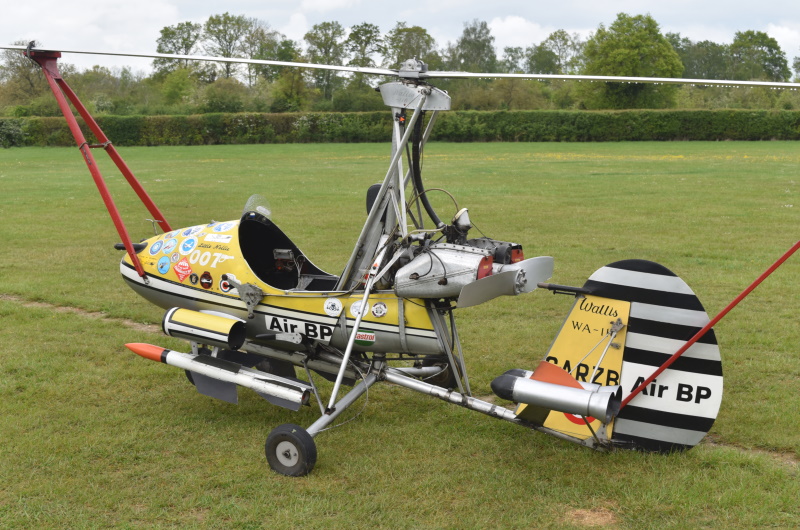
In 1967 a WA.116, LITTLE NELLIE, was used in the Sean Connery James Bond move YOU ONLY LIVE TWICE. The gyroplane was fitted with an impressively dubious array of lethal armament -- including heat-seeking missiles that could do a U-turn after being fired forward and attack a pursuer, an impossibility at the time. Wallis did the honors for piloting the machine in the movie. The Wallis designs have proven an inspiration for gyroplane kit makers elsewhere. Bensen-style designs continue to be built as well; the plans for one such, the "Gyrobee", are available free on the internet to anyone who wants to build one.
There were other, less spectacular efforts to push gyroplane technology in the 1960s. A pair of two-seat autogyros for the commercial market, the McCulloch J-2 and the Umbaugh U-18A, were designed and received FAA certification, but less than a hundred of each were sold. For the rest of the century gyroplanes would remain a hobbyist technology, with a number of companies selling them into that market, often as kits.
BACK_TO_TOP* The Bensen gyrocopter and its contemporaries kept the gyroplane alive, but all efforts to develop more capable machines in the meantime failed. Attempts to revive Pitcairn and Kellett designs went nowhere. However, an attempt to build a large gyroplane, a machine much larger and more capable than anything Cierva ever seriously thought of building, proved impressive, if still a failure in the end.
The Fairey "Rotodyne" was the brainchild of the Cierva company's Dr. Bennett and Captain A. Graham Forsyth. They had worked on the concept from the late 1940s using a series of relatively small "Gyrodyne" demonstrators, leading to the initial flight of the full-scale Rotodyne on 6 November 1957. It was something like a small airliner with a capacity of 50 passengers, clamshell doors in the rear for cargo loading, twin Napier Eland turboprop engines providing 2,090 kW (2,800 HP) each, stubby wings, twin tailfins, and a four-blade rotor.
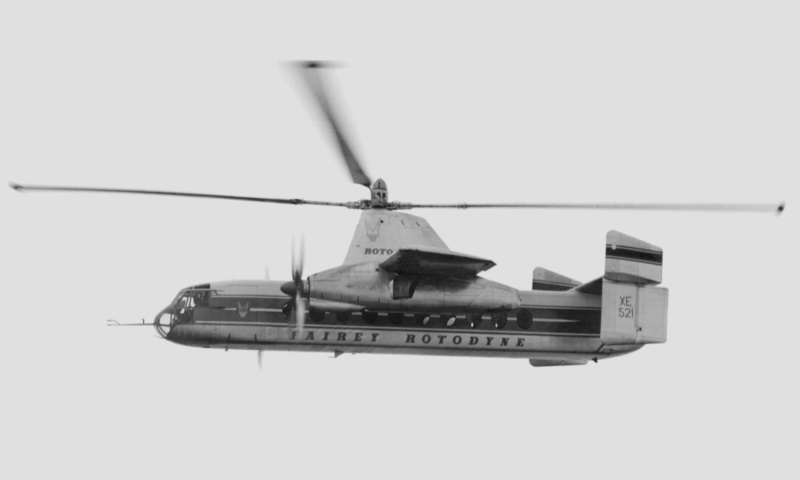
It wasn't exactly an autogyro. It could perform vertical take-offs and landings; compressors driven by the turboprops drove air jets out to combustors at the tips of the rotor blades, permitting the Rotodyne to perform vertical take-offs and landing. In forward flight the rotor simply spun freely, as it did in a gyroplane, with the machine flying generally as a fixed-wing aircraft. It did not have the flight agility of a helicopter, but it was an impressive aircraft, with a top speed of 320 KPH (200 MPH), and got a lot of press at the time.
___________________________________________________________________
FAIREY ROTODYNE:
___________________________________________________________________
rotor diameter:
27.43 meters (90 feet)
wingspan:
14.17 meters (46 feet 4 inches)
fuselage length:
17.88 meters (58 feet 7 inches)
height:
6.76 meters (22 feet 1 inch)
empty weight:
10,000 kilograms (22,000 pounds)
max loaded weight:
15,000 kilograms (33,000 pounds)
cruise speed:
300 KPH (185 MPH / 160 KT)
ceiling:
4,000 meters (12,200 feet)
range:
725 kilometers (450 MI / 390 NMI)
___________________________________________________________________
A license agreement was signed with Kaman Helicopters of the US in 1958. Fairey was swallowed up by Westland the next year, but work was still proceeding on a 75-passenger stretched version powered by twin Rolls-Royce Tyne turboprops. The program then abruptly ran out of steam, with the prototype grounded in 1962, and later scrapped.
The reasons for the cancellation are still argued. The Rotodyne was very noisy, a problem commonly associated with tipjet rotorcraft, but work was underway to deal with the noise problem. The main problem seems to have been that prospective commercial and military buyers didn't materialize as expected, and so the additional development costs for the stretched capable production variant were hard to justify. Some admirers of the Rotodyne suggest that more might have been made of it if the British government had been more enthusiastic about the project; that's also arguable, but it was an era when the British government seemed to take pleasure in killing off promising aerospace programs.
* The USSR also built a gyrodyne -- that name stuck to the general configuration -- the Kamov "Ka-22", in the same class as the Rotodyne, though of considerably different and arguably less elegant appearance. The Soviets called it the "Vintokyrlya (Screw Wing)", while NATO gave it the reporting name of "Hoop". It featured a turboprop on each wingtip, driving a forward propeller in flight and a rotor for take-off; fixed landing gear; and a high-perched canopy to give the flight crew a good field of view. The boxy fuselage was apparently derived from that of the Antonov An-8 turboprop cargolifter.
The project was initiated in late 1954, before the Rotodyne had been completed. The early date shows that the Ka-22 was not a copy of the Rotodyne, as some sources have hinted -- oblivious to the fact that while the two machines were comparable in many ways, they were also clearly different at a detail level. Initial untethered flight of the Ka-22 prototype, fitted with Kuznetsov TV-2VK turboprops, was on 15 August 1959; there were serious control problems, but they were generally resolved in the flight trials program, with a order for three pre-production machines with D-25VK turboprops placed in 1960. The machine was displayed publicly at the Tushino Air Show near Moscow on 9 July 1961, causing something of a sensation.

The Ka-22 set a number of records for rotorcraft. One of the four Ka-22s crashed on 28 August 1962, killing all seven crew, but the accident was traced to a manufacturing defect, not a design problem. The program continued up to 12 August 1964, when another Ka-22 crashed, three of the crew surviving and two being killed. Enthusiasm for further work on the machine faded out; it might well have been made into something, but it was complicated, the engine and drive system proving a particular nuisance, and the Mil Mi-6 Hook heavy-lift helicopter seemed to do the job as a heavy-lift rotorcraft. The program was canceled, with advanced derivatives such as the "Ka-34" and "Ka-35" never going beyond the model stage.
BACK_TO_TOP* In the current day, gyroplanes appear to be alive and well, if not taking the world by storm. Between a dozen and two dozen firms are making gyroplanes worldwide -- often selling them as kits, along with finished aircraft. Most are two-seaters, with tandem or side-by-side seating, with open or enclosed cockpits, though some single-seaters and three-seaters are sold as well. They always have pusher props and fixed tricycle landing gear, some being offered with skis or floats as well. They increasingly have digitized cockpits with at least one flat-panel display.
The manufacturing scene is dynamic, always changing, but a sampling of current manufacturers includes Magni Gyro of Italy, Celier Aviation of Malta, AutoGyro GMBH of Germany, and Trixy Aviation of Austria. Vittorio Magni, mentioned earlier, got into gyroplanes in the late 1960s by building Bensen gyrocopters, gradually working his way up to founding a company that now bears his name, with a factory in Besnate. Magni Gyro has sold well over a thousand machines to this time, including:
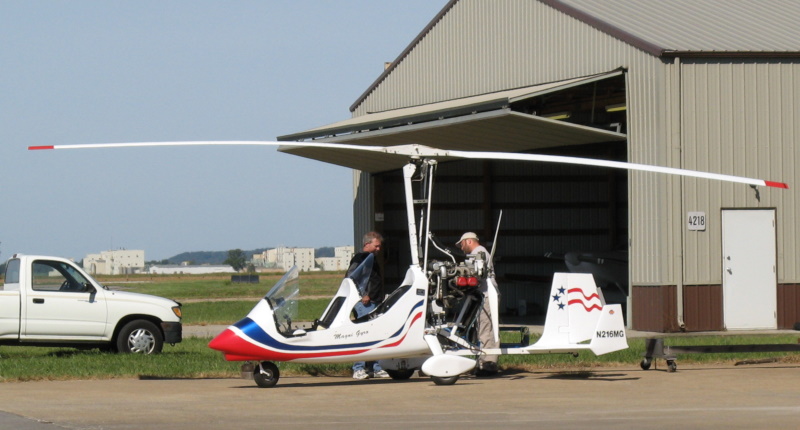
Celier Aviation was founded by Raphael Celier in 1993, to later relocate to Poland and then to Malta. It established its fortunes with the "Xenon 2" gyroplane, which was a side-by-side seat machine with an enclosed cockpit, with options for different Rotax 914 engine variants. It has been replaced in production by a three-seat derivative, the "Xenon 4".
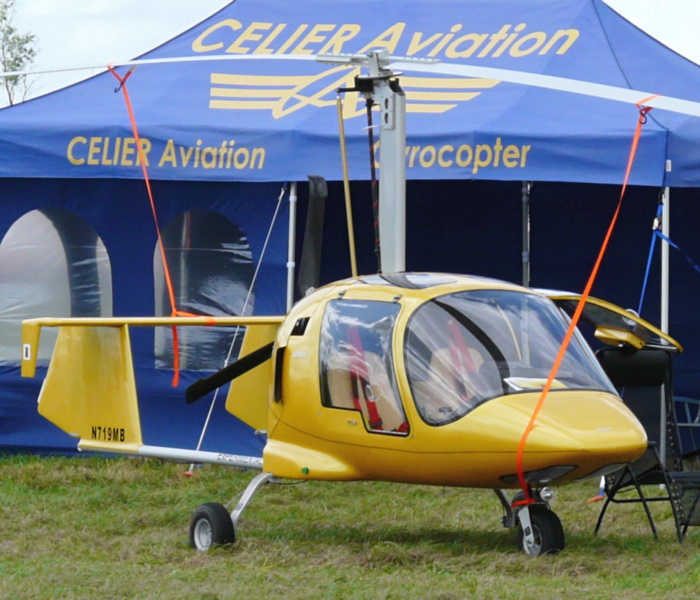
AutoGyro GMBH is based in Hildesheim, and has a range of models:
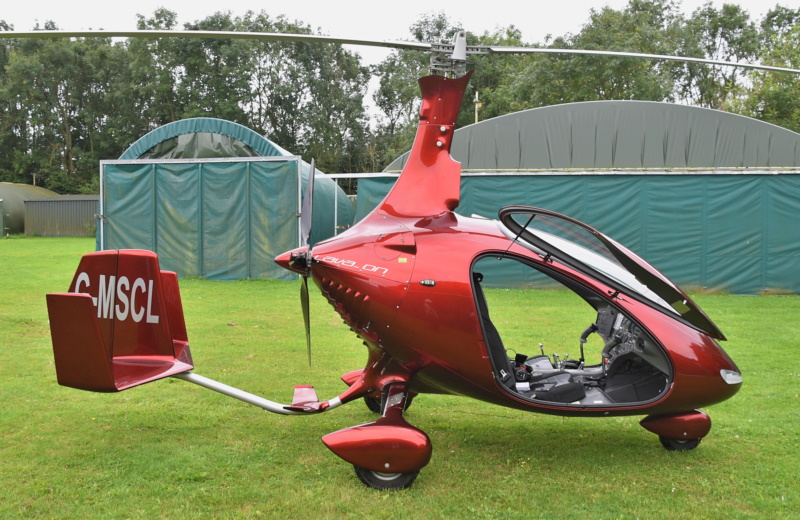
Trixy Aviation was founded by Rainier Farrag in 2010, and is based in Dornbirn. The company started out with a goal to design an enclosed electric motorbike that could be "plugged into" a flight airframe -- the gyroplane being seen as the initial option, with helicopter or fixed-wing aircraft down the road. To get started, the company focused on conventional gyroplane designs, including:
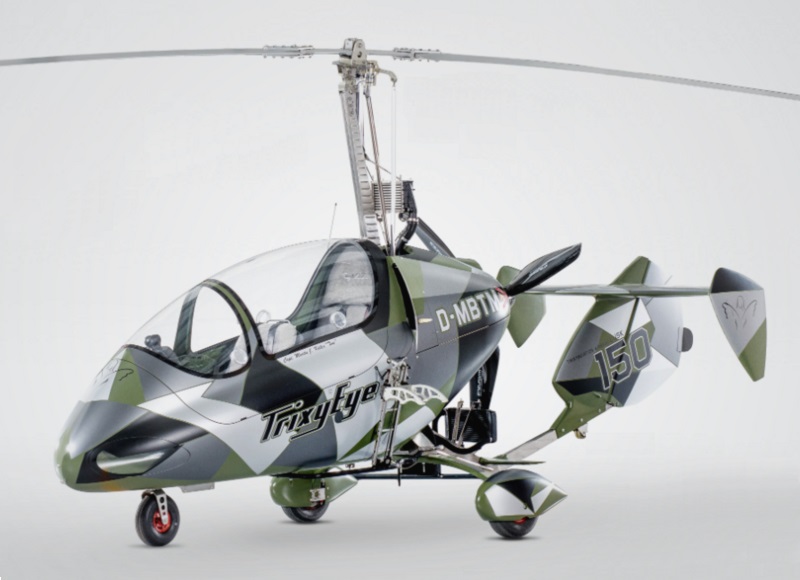
As far as the original goal of the company, a "TrixyFormer" demonstrator had been flown, but it's not a product yet. Gyroplanes from a number of European manufacturers have been evaluated by several military forces, but not yet adopted for service. They are, however, being flown in service with police, border patrol, and wildlife protection services in a number of Eastern European and African states, who need air support on a budget. There are tales that the Iranians fly gyroplanes of their own manufacture in military service -- which is plausible, the Iranians being ingenious in producing military gear on a tight budget, but they also lie a lot.
* There hasn't been as much enthusiasm for gyroplanes in the USA as there is in Europe, but two manufacturers -- Carter Aviation of Wichita Falls TX and Skyworks Global of Salt Lake City UT -- have worked on the technology. Carter Aviation was founded by Jay Carter JR in 1994, leading to flight of the side-by-side two-seat "CarterCopter" in 1999. The company promoted it as a "hybrid" air vehicle -- though on inspection it was of generally conventional gyroplane arrangement, with a two-bladed rotor and a pusher prop. It had an egg-shaped enclosed fuselage, a twin-boom tail, and long slender wings.
It did, however, have innovative features. The stiff, heavy "slowed rotor" featured depleted-uranium tips; at cruise speed, the rotor was feathered to prevent its drag from slowing down the aircraft, with the heavy tips ensuring that the rotor spin was smooth and continuous. Rotor controllability was aided by a tilting rotor mast. Unusually for a gyroplane, it had retractable landing gear.
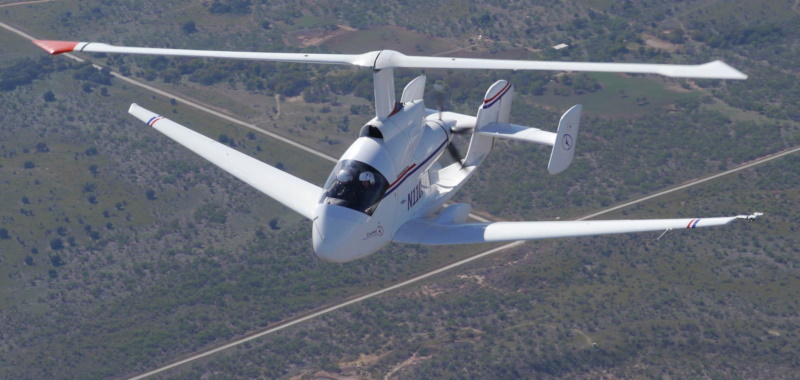
The CarterCopter crashed in 2005; it was so badly damaged that it was judged wiser to move on to an improved prototype, the CarterCopter "Personal Air Vehicle (PAV)", leveraging off the experiences with the original CarterCopter. The PAV was similar to the CarterCopter, but most distinctively had a single tail boom, instead of the twin tailbooms of its predecessor. The first PAV performed its initial flight on 5 January 2011, with a second machine flying in 2014.
Carter, after a search for production backing, ended up being bought out by Jaunt Air Mobility (JAM) of Dallas, Texas, in 2019. JAM was set up to pursue development of an electric vertical take-off & landing (eVTOL) machine, with the company concept, the "Journey", having a somewhat more conventional arrangement. It features a two-blade rotor and four electric props. Introduction to service is slated for 2025.
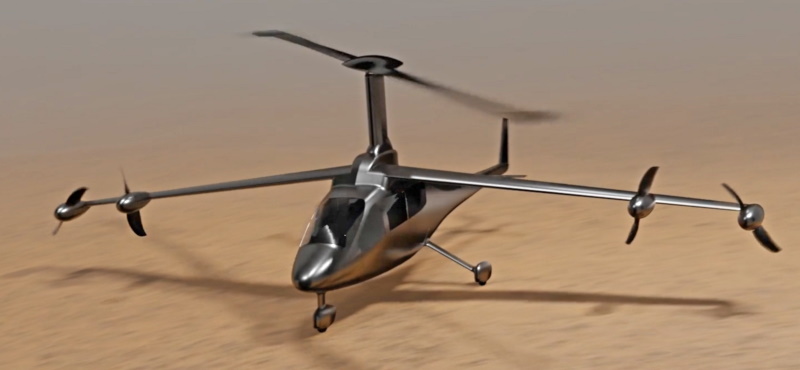
Skyworks Global was founded in 1986 by David Groen and his late brother Jay Groen, the company being originally known as "Groen Brothers Aviation (GBA)". They developed a series of "Hawk" demonstrators, leading up to the "Hawk 4T", with first flight in 2000. It was a four-seat gyroplane with a Rolls-Royce 250 turboprop providing 315 kW (420 HP) -- said to be the first turbine-powered gyroplane. It featured fixed tricycle landing gear, a twin-boom tail, and car-type doors on each side of the fuselage. It was modified to a 5-seat "Hawk 5" prototype.
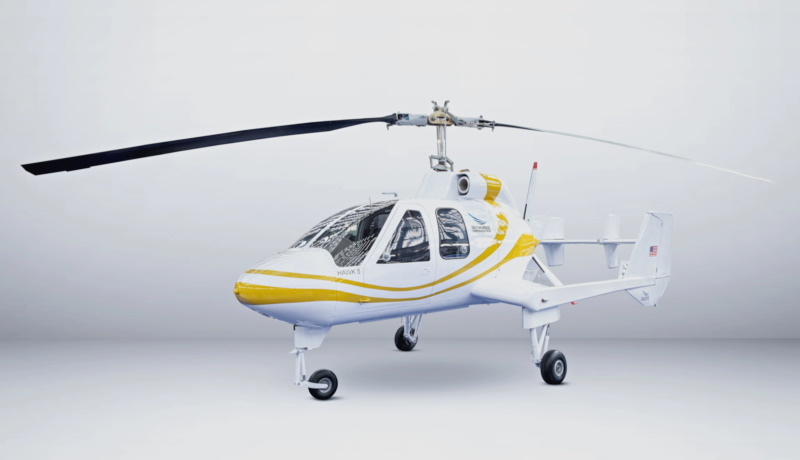
To help stay afloat financially, the Groen Brothers developed a more conventional 2-seat gyroplane, the "Sparrowhawk", which was sold by the spin-off "American Autogyros" company. In the meantime, the company came up with plans for much more ambitious tipjet gyrodynes, including a combat "Heliplane" for US Defense Advanced Research Projects Agency (DARPA) effort; a "gyroliner" with sizes ranging from 19 to 100 seats, being more or less a resurrection of the Fairey Rotodyne; and even bigger "gyrolifters", one concept being a gyrodyne derivative of the Lockheed-Martin C-130 Hercules four-turboprop cargolifter, named the "Monsoon", to be used for firefighting and other airlift chores.
The Groen Brothers couldn't make a go of their efforts and fell on hard times, but the company was resurrected as Skyworks, and is now working on a range of gyroplane / gyrodyne projects. The Hawk 5 is now being promoted, while the DARPA Heliplane concept has similarly re-emerged as the "Vertijet" concept; the company is also promoting a two-seat "optionally piloted" ScoutHawk for a range of missions.
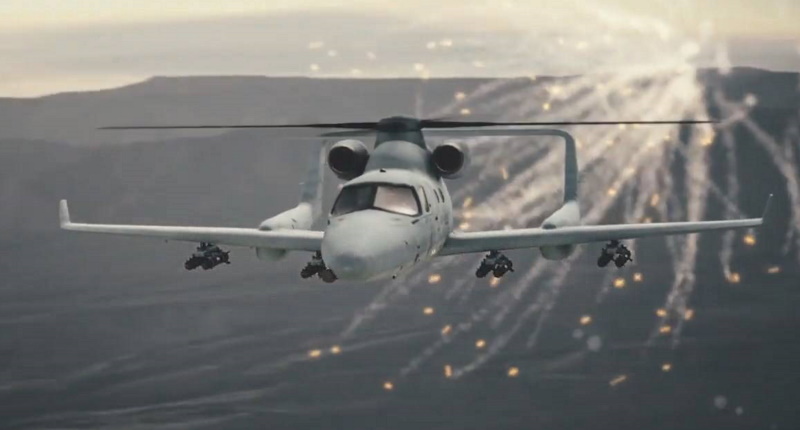
In addition, Skyworks is working on the "eGyro", a battery-electric gyrodyne, that will be able to carry 2 to 4 passengers, along with a pilot, at speeds of up to 240 KPH (150 MPH), and a modest range of 50 to 160 kilometers (30 to 100 miles). In any case, Jaunt and Skyworks have interesting ideas; it remains to be seen if they can make a go of them.
BACK_TO_TOP* A California company named SkyWindPower floated an idea for an unusual application of gyrokites, flying four-rotor systems on an "H"-configuration frame up into the jet stream to generate electric power. There are several companies working on kite power; none of them have gone very far yet, but we can be patient.
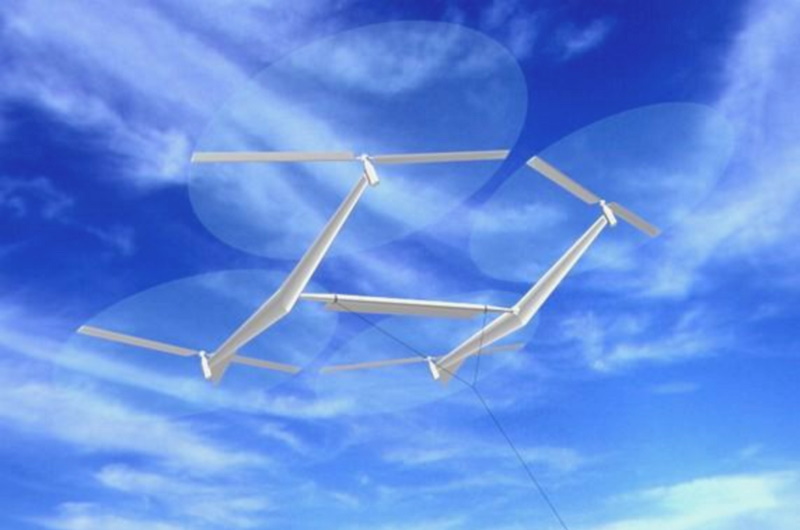
The proliferation of terms in this topic -- autogiros, autogyros, gyrocopters, gyroplanes, helikites, rotorkites, gyrokites, gyrodynes, rotodynes, heliplanes -- is confusing. I've chosen to focus on the terms "gyroplane", "gyrokite", and "gyrodyne", mostly out of simple preference. Trying to trace down the precise history of different types of gyroplanes is also very confusing, and I decided to give a quick mention of most types and focus on a few of the more representative or interesting machines. Most of the data on the more obscure gyroplanes is sketchy and untrustworthy.
* As a very minor final footnote: on 15 April 2015, a US Postal Service mailman named Doug Hughes flew a Bensen-style gyrocopter from Gettysburg, Pennsylvania, to Washington DC, and landed it on the grounds of the Capitol Building. He was hauling 535 letters, one for each member of Congress, to protest government corruption. He surrendered peacefully to Capitol Police officers.
Hughes was fired from the USPS, though he did successfully sue to get retirement benefits, and ultimately spent four months in lockup, followed by a year of probation. Comedian Jon Stewart titled the adventure WACK HAWK DOWN. Some applauded the stunt, others judged it foolish and hazardous -- Washington DC has defenses against air attack, though it seems the little low-flying gyrocopter didn't show up on radar. Hughes did end up creating an amusing chapter in the history of the gyrocopter.
* Sources include:
This document owes a good deal to a portion of "From Autogyro To Gyroplane: 1923:2003" by Dr. Bruce Charnov. Current gyroplane makers also often have useful websites.
* Illustration credits:
* Revision history:
v1.0.0 / 01 dec 06 v1.0.1 / 01 dec 08 / Review & polish. v1.0.2 / 01 nov 10 / Review & polish. v1.1.0 / 01 apr 11 / Fixed-pitch rotors, CarterCopter. v1.1.1 / 01 mar 13 / Review & polish. v1.1.2 / 01 feb 15 / Review & polish. v1.1.3 / 01 jan 17 / Review & polish. v1.1.4 / 01 dec 18 / Review & polish. v2.0.0 / 01 jan 22 / Extensive rewrite, new illustrations. v2.0.1 / 01 dec 23 / Review & polish. (*)BACK_TO_TOP
